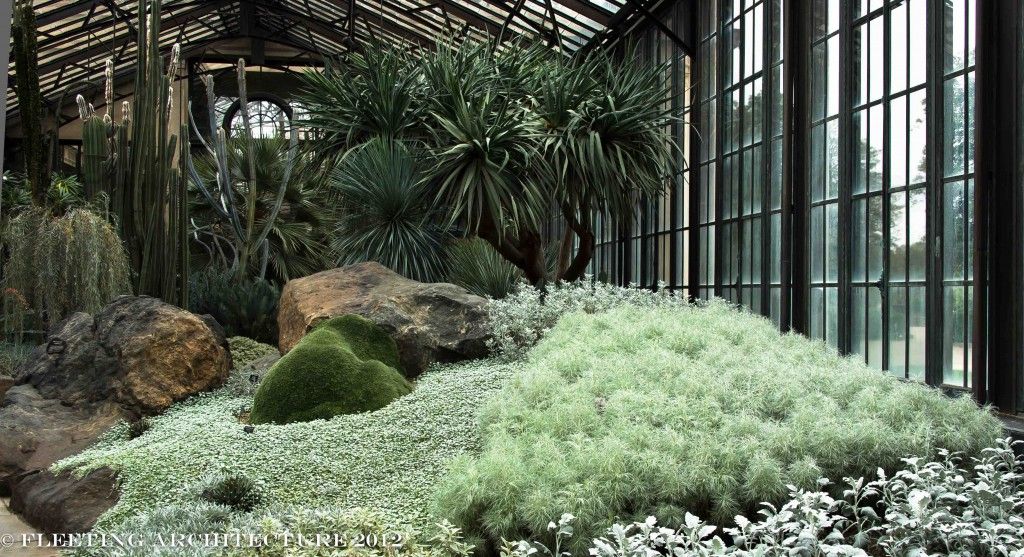“Sixteen years ago I was writing only prose and what I consider now traditional garden writing for magazines. And then one day I was in my office looking at a landscape architecture magazine, turned the page, and there was an image that had an enormous physical effect on me. I had a sense of utter physical certainty and determination that I would do whatever I had to do to stand in that place. I don’t know quite how to explain it, but it was nothing to do with my thinking. It had absolutely a physical kind of jolting experience.” — Poet Hazel White on Isabelle Greene’s Valentine garden, Natural Discourse lecture 2/10/12

Isabelle Greene’s Silver Garden at Longwood Gardens, photo included with kind permission of Fleeting Architecture
I’d resolved to attend as many of Lili Singer’s Thursday lecture series as the workweek allowed, which turned out to be not very many, but the 2/7/13 talk with legendary landscape architect Isabelle Greene was definitely not one to miss. Ms. Greene exudes every bit of wisdom and playfulness you’d expect from someone who has practiced an art that has continuously absorbed and replenished her astonishing creative energies for 49 years. She grew up steeped in a tradition of architecture that celebrates and integrates climate and landscape into a design vocabulary, the Arts and Crafts movement. Henry Greene was Isabelle’s grandfather. (Greene & Greene’s masterwork, The Gamble House in Pasadena, is open for tours.)
Ms. Greene’s speaking engagements are rare, so the turnout filled every seat, where we balanced notepads on our knees and scribbled away, taking notes as she coaxed and cajoled the audience through a garden design brainstorming session. The talk drew quite a few professional designers, and much of its focus was the designer/client relationship, but there was inspiration enough for both professional and layperson. Overall, Ms. Greene exhorts us to “listen to the site, the floor of everything.”
The following are excerpts from her handout, “Basic Elements in Designing.” There’s no time like spring for a refresher course in the fundamentals of design, and there’s no voice like Ms. Greene’s to get the juices flowing — playful, yes, but overlaid with a seriousness that knows a transcendent outcome is possible, because she’s accomplished it many times.
“Listen to yourself. Do you get that rush of excitement that tells you all your inner resources are on tap?
“Listen to the site. Soak up everything that’s there. Are you comfortable? Get comfortable. You must be in a good, even playful, mood, while at the same time deeply attending to the business, the seriousness. It is one of those stretches of mind and character that has to be achieved while designing.
“Now, have you yet begun to grasp onto something like a theme? Or a mood, or a SOMETHING that will let you attach onto it all the disparate parts that will make up this design — that will bring them into a single coherence? This is essential. It is the reason for being at your best when designing; on your very tippy toes. It is the ‘stretch,’ the embrace, that the process is all about. Do not think of proceeding without it.
“There should have come by now some actual images in your fired-up brain. Get them down, whatever it takes; that is your precious material. Don’t let it slip away — make sketches, make lots of notes, talk to somebody, or tell the world to go away while you cement and codify the gems and heart of your material. It can be an exhausting episode, pulling from half-remembered, half-sensed inner materials joined to the fresh, new material of the site, but stick at it: there will never be a more important moment than this.
“Think about making full use of everything you have available; incorporate the history that shows on the site; history is an asset and basic anchor in our rapidly moving times. Incorporate as many parts of existing structures or parts as can be useful, as well as refreshing their materials toward new purposes. The imagining of what use can be made of existing material often drives a design to new and unexpected dimensions.
“Lastly, always remember to use your imagination. You are unique, and the situation — each situation — is unique. This is your chance (a rare chance for adults) to be child-like with wonder, to know no defined boundaries; your head can be as playful as you remember how to be. (Plenty of time later to delete, to weigh alternatives, to checklist safety into your project.) But this is the only time to springboard something new into this world.”
I’ve included a photo, with the kind permission of Fleeting Architecture, of Ms. Greene’s design for the Silver Garden at Longwood Gardens, which I think demonstrates Ms. Greene’s imaginative response when the “site” is a public conservatory, a relatively constrained space that offers inspiration for small gardens, instead of a more complex, multi-part landscape.
The Thursday Talks with Lili Singer are held at the Los Angeles Arboretum. There is a wonderful documentary “Women in the Dirt” that includes Ms. Greene in its profile of seven prominent landscape architects.
Oh, one last word of advice from Ms. Greene: “Mulch — mulch everything, everywhere.”

That must have been quite the event. Thanks for the summary! Grandchild of a Greene & Greene, what a heritage.
I should go to more stuff like this, but at least I spend a lot of time mulching. 😉
Hoov, I don’t know how you manage it all. Too bad you can’t harness up those no-account pups and make them pull their weight (just kidding, Boris & Natasha!)